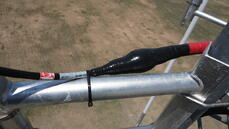Outdoor wireless systems that are properly engineered and designed can provide 99.999% predictable uptime reliability. When wireless backhaul networks are designed factors like path loss, Fresnel Zones, and weather are calculated to provide an accurate determination of which frequency is to be used, antenna output gain, transmit power of the radios, antenna heights, and modulations.
Properly designed systems use the correct antennas, frequencies, and transmit power to overcome the Path Loss and account for weather conditions to get the desired Receive Signal Level ("RSL" measured in dBm). Radios are designed to operate with a certain level of "Fade Margin" that allows the system to operate at a predictable reliability (for most systems 20 to 25dB of Fade Margin is recommended).
Wireless backhaul, whether you are talking about wireless mesh, WiMax, point to multipont wireless, or point to point wireless backhaul, systems can function with extreme reliability and predictability if installed correctly. Proper installation is a critical component of the success and longevity of an outdoor wireless system. One of most important parts of the installation process is performing quality weather proofing of all components.
Weatherproofing gets overlooked all the time. When a system is working a broadband wireless network gets forgotten about and really inspected. Weatherproofing doesn’t last forever and needs to be inspected annually and should be replaced if any deficiencies are found. All cable connections, whether at the termination of the radio, at the lighting surge arrestors, or at any other junctions.
Proper weatherproofing is done using butyl tape and high quality polyurethane UV resistant tape. Good practice is to apply tape first, then apply butyl (which prevents any moisture to get through), and then an outer layer of tape. Tape should be wrapped in an overlapping shingling fashion. Over time though even though resistant to UV, tape can loose its adhesive and peel away. Annual inspection and re-taping should be performed.
One of the most difficult problems to troubleshoot on an outdoor wireless backhaul system is failure due to moisture in a connection or water that gets in a cable. Many times this issue cannot be easily visible on a surface inspection. The best way to avoid issues caused by weather is to maintain proper weatherproofing from the beginning.
Properly maintained outdoor wireless bridge systems should remain functioning as originally designed and specified. By performing periodic maintenance and re-certification a properly designed and installed system should perform exactly as it did on the original install date.





